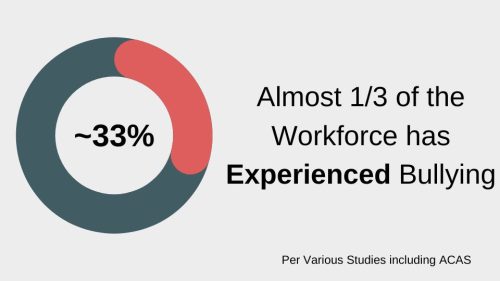7 Steps To Tackle Bullying At Work

Being bullied at work is horrible. Bullying saps confidence, your focus on work, your time, and your motivation. It takes effort and emotional resilience to tackle bullying at work. Even worse is not doing anything. This give a bully free reign which is likely to mean the bullying continues or gets worse. This will not help your happiness, nor your motivation nor performance at work.
I am taking your through 7 steps to tackle bullying at work, to give you confidence and knowledge of what steps you can and should take.
Around a third of the workforce has personally experienced bullying per various studies including ACAS. Nearly a further third have witnessed bullying at work. 68% said the bullying at work was “subtle”. Bullying is surprisingly common at work, so it makes sense to know what to do when you see or experience bullying yourself.
7 Steps to Tackle Bullying at Work
- Check Your Company’s Policy
- Start Collecting Evidence
- Have an Informal Conversation
- Speak to Your Manager
- Find Allies
- Escalate to HR and Senior Management
- Escalate externally to lawyers and tribunals
These steps give you escalating ways to tackle bullying at work.
At the end of this article, I will share what to do when a manager is the bully, which unfortunately is the case in over 50% of bully at work according to the research.
Watch on YouTube
Listen on Podcast
Firstly, ask yourself are you being bullied
Bullying is repeated behaviour that is meant to hurt and control another person. We all make mistakes and say or do dumb or insensitive things at times. Bullies repeat behaviour they know hurts or controls others again and again over time. That is quite different from making one-off mistakes
If you feel singled out by a pattern of negative behaviour, then chances are you are being bullied. Think about why you are being singled out. Some of the reasons I have come across include:
- You professionally threaten the other person for example by doing a better job than them
- You aren’t agreeing to do what the other person wants you to do
- You have hurt or annoyed the other person and they respond with bullying tactics
- They don’t like you on a personal level, or you intimidate them in some way – for instance being more popular
If you can work out why they feel threatened by you or why they might be bullying you, you may be able to address their concerns and insecurities in a constructive way which avoids you appeasing the bully.
Be sure you are being bullied before taking the following steps. Take a look at our How to Spot Bullying on Your Team for 17 signs of being bullied.
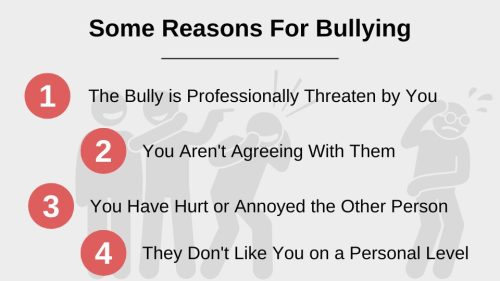
Check your company’s policy – The first step to tackle bullying at work
Your company should have an employee handbook or employee policy document that sets out the rules the company expects everyone to follow. This document also contains the procedures the company should follow in dealing with breaches of those rules which will include bullying.
By reviewing your company’s employee policy handbook, you learn what procedures the company should follow and what protections should be available to you to help tackle bullying at work. There may be dedicated individuals you can speak to confidentially about the bullying in the workplace you are experiencing.
Learn what your company’s policies are towards bullying.

Start collecting evidence – The second step to tackle bullying at work is to
Because at least two thirds of bullying action is subtle – such as not inviting you to meetings, not sending you important information to do your job, teasing etc, collecting evidence is an essential step to start as soon as possible.
Use a notebook or save notes on a flash drive and capture:
- What happened
- When it happened
- Where it happened
An example – Jill organised the sales meeting on 11th November at 10am but did not send me an invite for this meeting until 3 minutes before the meeting was due to start.
Or “On 27th October at 10.05 David spent 10 minutes teasing me about supporting Spurs. He did not tease anyone else despite most people supporting different teams”
On their own, these examples appear fairly innocuous. They could easy be mistakes or one offs.
Bullying is repeated behaviour aimed to hurt or control. Therefore you must collect enough examples to demonstrate a clear pattern of negative behaviour towards you.
For instance, if you had 20 examples of David teasing you while not teasing others within 2 months, that would be pretty hard to ignore as an example of bullying.
Start gathering examples and evidence as soon as possible to tackle bullying at work. Keep collecting examples and evidence until the bullying stops.
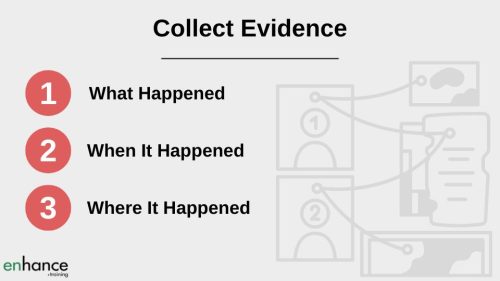
Have an Informal conversation – The third step to tackle bullying at work
It can be tough to get up the courage to have a conversation with the person bullying you. Standing up to bullies is a good way to get them to stop their bullying behaviour.
So book a meeting room or find somewhere quiet and ask the bully to meet with you. Follow an escalating meeting structure something along the lines of:
- Set out the bullying behaviour you are experiencing and ask them to stop
- Ask the bully why they are using bullying tactics and listen to their response. See if you can negotiate a settlement that you are both okay with. Remember – don’t appease or give in to their demands. Find a position you are both okay with or choose not to agree.
- Provide some specific examples to the bully to demonstrate that you have evidence of their bullying tactics and ask them to stop
- Tell the bully if they don’t stop their bullying tactics, then you will escalate to management and HR
You may come up with better steps to fit your situation. Escalate the pressure on the bully to stop their bullying tactics as you go through your informal conversation with them.
Be confident and be determined. If the bully sees you are not going to back down or put up with their behaviour, they are much more likely to stop the bullying.
Be prepared for denial, for anger and aggression or for more overt bully tactics during the meeting and for them to increase the frequency and severity or increase the subtly of their bullying tactics after the meeting. These may all happen. Be prepared.
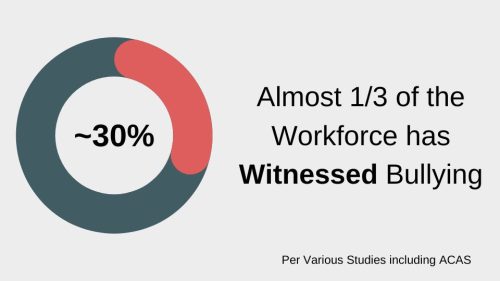
Speak to Your manager – The fourth step to tackle bullying at work
After having an informal conversation to tackle the bully and if the bullying has not stopped, speak to your manager.
Take your manager through:
- The issues you are having and the impact of the behaviour on you and as a consequence the team and your manager
- The examples that you have collected to date to prove that bullying is taking place and show you are the victim.
- The informal conversation you had with the bully
- Ask for your manager’s advice and for your manager to speak to the bully and ask them to stop their bullying.
Your aim is to win the support of your manager. Their support will make any further escalation steps needed – a lot easier to take.
Follow up with your manager after this conversation to find out what actions they have taken to help you tackle bullying at work.
Keep the pressure up on your manager to act, without annoying your manager or losing their support.
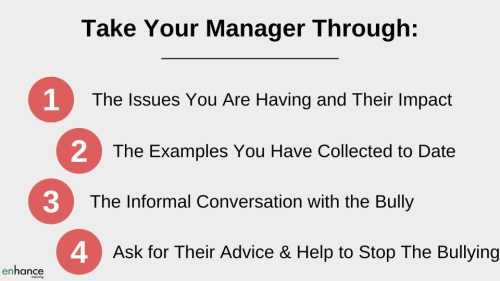
Find Allies – The fifth step to tackle bullying at work
After speaking to you manager, or alongside getting your manager’s support, another step you should consider is to find allies.
Find out if other colleagues are suffering bullying tactics from the bully – either in your team or further afield in the company. Do this carefully and subtly.
If you can add their examples to your own examples, you will dramatically strengthen your case and the pressure on the bully to stop. Few managers or HR will be able to ignore multiple employees being targeted by a bully.
In addition, look for other managers who might support you. Who do you have good relationships with manager who you can ask for help to pressurise the bully to stop? Multiple managers pressurising a bully is much better than one.
If your manager is the bully, get as many allies as possible at or above your manager’s level.
Escalate to HR and Senior Management – The sixth step to tackle bullying at work
If you manager and your allies have been unable to tackle the bullying at work successfully, the next step is to escalate to HR and potentially senior management. This step takes the bullying behaviour to a much more formal setting. You may need to lodge a formal grievance depending on your HR policies.
Take HR through all the steps you have taken to date and take them through your evidence you have collected. Discuss with HR what actions to stop bullying at work they are going to take.
I would suggest that you keep a copy of all the evidence you have gather on a personal flash drive or on other devices belonging to you. Remember, HR’s key job is to reduce the risk to the company which does not always mean they do what is right.
Escalate externally to lawyers and tribunals – The seventh step to tackle bullying at work
If you have been unable to stop the bullying in the workplace through the use of the first six steps, then your choices are to escalate the matter externally or to leave the business. If you considering this step, your bully is likely to a manager who has used their greater power and influence to persuade the company to ignore your situation.
This is a very tough place to be in, particularly if you love your job and don’t want to leave. Using tribunals and the legal process is a very time consuming and energy consuming process. It is stressful and you are likely to be fighting against the company in some way. Before you start on this route, ask yourself if winning at tribunal or through the legal process is worth all the effort you will need to put in versus putting that same effort into getting and succeeding in a new job with a company that treats their staff better? Fighting for what is right may be more important to you.
The very best of luck to you either way.
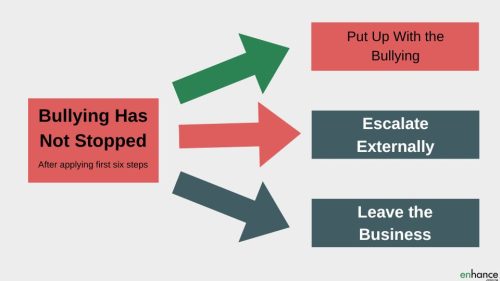
As promised, let’s talk about
how to stop bullying in the workplace by your manager
Being bullied by your manager is a particularly tough and nasty position to be in. Your manager should be one of your key supporters if you are being bullied.
Take the same steps as we have just been through.
When you gather your examples and evidence, make it as specific and detailed as possible. Your examples will need to be even more convincing as your manager is likely to have more influence in the business than you do. Make sure the pattern of behaviour is very clear through your examples. Always keep a copy of your evidence on your own devices.
I also suggest to start looking for and sounding out allies after you start to gather evidence. You will need to negate the greater influence your manager has within the business through the allies you cultivate and the evidence you gather.
Do you best to have an informal conversation with your manager following the suggested escalation process we talked about earlier. Of course adapt this to your circumstances and with your knowledge of your manager.
If your informal conversation with your manager doesn’t stop the bullying, then escalate to HR and senior management. The next step would be to escalate externally.
A good supportive HR team should take sensible action to investigate your claim of your manager undermining you and bullying you. . The better your evidence and the more professional you are throughout the process, the more likely you will get a positive result i.e. the bullying stops. Practically, it makes sense that the manager who was bullying you does not remain your manager if they stay in the business.
Good luck.
In Summary
Knowing the steps to tackle bullying at work is very helpful if you are being bullied. Taking these steps requires courage and determination. It is not easy confronting a bully at work. Not confronting a bully is nearly always worse for you, so please put these steps into practice.
As a reminder they are:

If you struggle to confront the bully personally, ask others such as your manager or allies to confront the bully for you.
Be proactive and take steps to demonstrate to the bully that you will not put up with the treatment you are receiving.
Good luck
Being bullied at work by colleagues is pretty horrible and being bullied by a manager a lot worse. I have personally experienced both and I feel I am an unlikely candidate for bullying. It is easy to feel isolated without anyone to turn to. There is a lot you can do to proactively help yourself when you are being bullied. Do take action, using your version of these steps. Doing nothing is the worst move as it gives the bully free reign.

